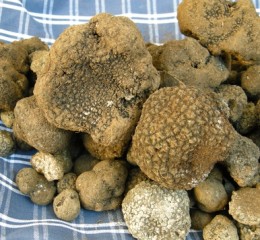


There are two great truffle families. White truffles, including the Tuber Magnatum (or white Alba truffle), the Tuber Borchii (the “Bianchetta” for the Italians) and the Tuber Aestivum (summer truffle). In the black truffle family, there are the Tuber Melanosporum (the famous black Perigord truffle), the Tuber Uncinatum (Bourgogne truffle) and the Tuber Mesentericum (Mésentérique truffle). The uncontested star is the black Perigord truffle, however the Mésentérique has its fervent defenders due to the strength of its perfume. You will find details of these different truffles on the “Type of Truffle' pages. Each truffle has different qualities which are classified in three different categories. The 'first-rate' category is for top-quality whole truffles. They must have a rounded form and be fairly regular, without signs of damage and with a regular colour. In Category '1' are good quality, whole truffles although there there may be small marks made by predators or irregularities of colour or shape. Such defects must not compromise either the taste of, or ability to keep, the truffle. In Category '3' there are either whole truffles or pieces of truffle which have more marked irregularities of shape, colour or appearance. The Melanosporum (the black Perigord truffle) is the best and most sought-after truffle. Logically, therefore, it's the most expensive. If the Perigord truffle costs 100, Tuber Mesentericum (Mésentérique) will be 15, the summer truffle (Tuber Aestivum) 20, and the Bourgogne truffle (Tuber Uncinatum) will be 50.
Tuber Aestivum os known as the summer truffle, Saint John's truffle or 'early summer'. It owes its nicknames to to its unusual harvest period - from May to September, other truffles being gathered in the autumn. Its outer colour is grey and its flesh is beige. It gives off a delicate hazelnut perfume. Although this truffle is not very hardy, it is reasonably priced. Its aroma is much less pronounced than the Bourgogne or Perigord truffles. We recommend that it be bought fresh and eaten as quickly as possible so as to make the most of it. Ideally grate it on fish, meat or salads.
Tuber Uncinatum - also called the Bourgogne truffle, the Champagne truffle, the Lorraine truffle or the Haut-Marne truffle - is a really high-quality truffle. It's also called the grey truffle because of its deep brown colour tending towards black. Its chocolate-coloured flesh has a delicate perfume which is less strong than the Perigord truffle. /// Unlike the black Perigord truffle - a mushroom found in open clearings because it enjoys the warmth – the Uncinatum prefers shady areas. Generally, natural truffle areas will be established in formerly cultivated areas which the forest has re-taken. /// The natural geographic zone of the Tuber Uncinatum extends from the Mediterranean as far as Russia. Its capacity for adaptation makes it the candidate of choice for truffle culture in orchards.
Tuber Mesentericum, or the Mésentérique truffle, has often been disdained because of its overpowering aroma and its particularly intense taste. The perfume of humus is tinged with a hint of liquorice. It's principally found in eastern France, Italy and Switzerland in sloping calcareous soil. Mostly collected wild in the Lorraine, there's little farming of this variety. Its shape is rather irregular, skin black and flesh a chestnut-chocolate colour marbled with white. Gathered end-September to end-December. Culinary advantage: the Mésentérique truffle can be cooked at low temperatures.
Tuber Magnatum, also called the white Alba truffle or Piedmont truffle is to be found in northern Italy or the lower valleys of the Rhône. It likes growing near poplars and willows in calcareous-clay earth. Like the other white Italian truffle, Tuber Borchii, it outwardly resembles a potato (but the Magnatum is twice the size of the Borchii and has a more delicate taste). Its outer colour varies between yellowish-grey and ochre with touches of green. Its taste hints at fresh garlic or shallots. The white Magnatum truffle is eaten raw, grated on pasta or rice.
The Tuber Borchii or Blanchette truffle or Albidum Pico is very similar to the other white Italian truffle, the Magnatum truffle. It is smaller, but apart from its size only an expert can tell it apart. Its perfume is very similar, although less intense than the Borchii truffle. While the Magnatum grows in a tiny geographic area, the Blanchette truffle can be found from Sicily to Finland … even in Perigord which can surprise the black truffle caveurs. Eaten raw, it is grated on potatoes or toast drizzled with olive oil and cooking salt.